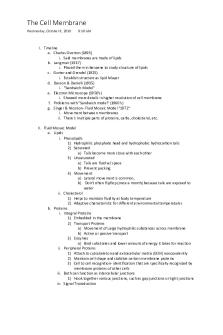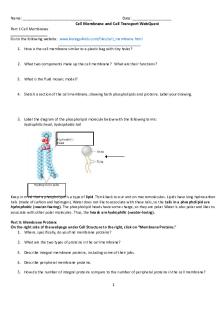Cell Membrane and Cell Transport Web Quest 1v8cdxj 19nbdzl PDF

| Title | Cell Membrane and Cell Transport Web Quest 1v8cdxj 19nbdzl |
|---|---|
| Author | Anonymous User |
| Course | Cell Biology |
| Institution | California State University Channel Islands |
| Pages | 4 |
| File Size | 239.4 KB |
| File Type | |
| Total Downloads | 28 |
| Total Views | 180 |
Summary
its hard...
Description
Name: __________________________________
Date: ___________________
Cell Membrane and Cell Transport WebQuest Part I: Cell Membranes Go to the following website: www.biology4kids.com/files/cell_membrane.html 1. How is the cell membrane similar to a plastic bag with tiny holes?
2. What two components make up the cell membrane? What are their functions?
3. What is the fluid mosaic model?
4. Sketch a section of the cell membrane, showing both phospholipids and proteins. Label your drawing.
5. Label the diagram of the phospholipid molecule below with the following terms: hydrophilic head, hydrophobic tail
Keep in mind that a phospholipid is a type of lipid. Think back to our unit on macromolecules. Lipids have long hydrocarbon tails (made of carbon and hydrogen). Water does not like to associate with these tails, so the tails in a phospholipid are hydrophobic (=water-fearing). The phospholipid heads have some charge, so they are polar. Water is also polar and likes to associate with other polar molecules. Thus, the heads are hydrophilic (=water-loving). Part II: Membrane Proteins On the right side of the webpage under Cell Structure to the right, click on “Membrane Proteins.” 1. Where, specifically, do you find membrane proteins? 2. What are the two types of proteins in the cell membrane? 3. Describe integral membrane proteins, including some of their jobs. 4. Describe peripheral membrane proteins. 5. How do the number of integral proteins compare to the number of peripheral proteins in the cell membrane? 1
Part III: Membrane Transport On the top blue bar, click on “function” and find “passive transport” in the far right column. If you cannot find it, the URL is: www.biology4kids.com/files/cell2_main.html 1. How does passive transport differ from active transport? 2. Two types of passive transport (movement of molecules across a membrane that does not require energy) include ___________________ and _______________________. 3. What do some proteins act as to aid in moving molecules across a membrane? 4. What do you think semi-permeable means? (permeable means to pass into or through). 5. What is facilitated diffusion? Does it require energy to occur?
6. What is an example of a molecule that cannot cross the membrane by simple diffusion? 7. Molecules that move from high to low concentration are said to be moving down a __________ ____________ 8. Make a sketch showing molecules in high concentration on one side of the membrane, and in low concentration on the other side of the membrane and the movement of molecules down a concentration gradient.
9. How are small molecules able to freely cross the membrane without an input of energy? 10. What is osmosis? 11. In terms of ion concentration, what type of homeostasis needs to be established for a cell to survive? 12. What will happen if red blood cells are placed in water? Why does this happen? On the right side of the webpage under Cell Function, click on “Active Transport.” 13. What is active transport? 14. Why does the cell sometimes have to expend energy to move individual molecules across the cell membrane? 15. Which membrane molecules do most of the work in active transport? 16. Since these membrane proteins span the entire length of the lipid bilayer, what type of protein are they? ( hint: see part II, question #3). 17. Membrane proteins are very __________________, meaning that they are designed to move only one or two types of molecules or ions across the membrane. 18. What does it mean by proteins working against a concentration gradient? 19. Sketch a diagram of active transport, showing the phospholipids and the proteins in the membrane. Also make sure to represent that the molecule is moving from low to high concentration.
2
Part III: A Closer Look at Membrane Structure and Transport Go to http://www.phschool.com/science/biology_place/biocoach/biomembrane1/intro.html Click on “Concept 1” to the left. Concept 1: Membrane Structure Membranes consist of a ________________________ _________________ combined with a variety of __________________ in a fluid __________________ arrangement. The surfaces of cell membranes are ________________________ (water-loving); the interiors are ______________________ (water-fearing). Hydrophilic molecules tend to interact with ______________ and each other. Hydrophobic molecules _________________ interaction with water and tend to interact with other _______________________ molecules. Concept 2: Osmosis Osmosis (movement of ______________ across membranes) depends on the relative ____________________________ of solute molecules on either side of the ________________________. The presence or absence of cell ______________ influences how cells respond to osmotic fluctuations in their environment. Click on “Review” in the upper right hand corner. Concept 2 Review: Isotonic, Hypotonic, and Hypertonic Solutions Water moves readily across cell membranes through special protein-lined ___________, and if the total concentration of all dissolved solutes is not ________________ on both sides, there will be net ____________________ of water molecules into or out of the cell. Whether there is net movement of water into or out of the cell and which _____________________ it moves depends on whether the cell’s environment is isotonic, hypotonic, or hypertonic. Label the three illustrations below as isotonic, hypotonic, or hypertonic.
Click “Next” on the bottom left side of the screen. Concept 2 Review: Cells in Isotonic Solutions When two environments are isotonic, the total concentration of dissolved solutes is the _________________ in both of them. When cells are in isotonic solution, movement of water out of the cell is exactly ____________________ by movement of water into the cell. A _____________ solution of NaCl (saline) is isotonic to __________________ cells. Select “animate” to watch the movement of water molecules through protein channels in the cell membrane in an isotonic solution. Click “Next” on the bottom left side of the screen. Concept 2 Review: Cells in Hypotonic Solutions Hypotonic comes from the Greek “hypo,” meaning ______________ and “tonos” meaning ___________________. In a hypotonic solution, the total concentration of all dissolved solute particles is ______________ than that of another solution or less than that of a ________________. If concentrations of dissolved solutes are less ________________ the cell than ________________, the concentration of water outside is correspondingly greater. When a cell is exposed to such hypotonic solutions, there is net movement of water _______________ the cell. Cells without cell ______________ will swell and may 3
______________(lyse) if excess water is not removed from the cell. Cells with cell walls often benefit from the _______________ pressure that develops in hypotonic environments. Select “animate” to watch the movement of water molecules across the cell in a hypotonic solution. Click “Back to Review” and then select “Next”. Concept 2 Review: Cells in Hypertonic Solutions Hypertonic comes from the Greek “hyper,” meaning _____________, and “tonos,” meaning stretching. In a hypertonic solution, the total concentration of all dissolved solute particles is __________________ than that of another solution, or greater than the concentration in a ______________. If concentrations of dissolved solutes are greater _________________ the cell, the concentration of water outside is correspondingly _______________. As a result, water inside the cell will flow __________________ to attain equilibrium, causing the cell to _______________. As cells lose water, they lose the ability to __________________ or __________________. Hypertonic environments, such as concentrated brines or _________________, have been used for food preservation because microbial cells that would otherwise cause spoilage are _____________________ in these very hypertonic environments and are unable to function. Select “animate” to watch the movement of water molecules across the cell in a hypertonic solution. Select “A Closer Look” to see plant and animal cells in hypertonic environments on the bottom of the page. Compare and contrast what happens when a plant cell and animal cell are placed in a hypertonic solution. Close the review screen you are on to go back to the BioCoach Activity. You should still be on Concept 2: Osmosis. Click “Next Concept.” Concept 3: Selective Permeability of Membranes Cell membranes are selectively permeable. Some solutes can cross the membrane ______________, some cross with ____________________, and others do not cross at all. A few lipophilic (lipid-loving) substances move freely across the cell membrane by _________________ __________________. Most small molecules or ions require the assistance of specific ________________ ____________________ to transport them across the membrane. _______________ molecules do not cross intact cell membranes, except in certain special cases. Concept 4: Passive and Active Transport Most biologically important solutes require ________________ carriers to cross cell membranes, by a process of either _____________ or ________________ transport. Active transport uses _______________ to move a solute “uphill” against its gradient, whereas in facilitated diffusion, a solute moves _____________ its concentration gradient and no ________________ input is required. In the illustration below, label which type of transport is shown: facilitated diffusion or active transport.
4...
Similar Free PDFs

6-cell membrane web quest
- 4 Pages

Cell Membrane Coloring Worksheet
- 2 Pages

The Cell Membrane
- 2 Pages

4- Cell Transport Review
- 4 Pages

Cell Transport Review Worksheets
- 8 Pages

Cell Transport Activity
- 3 Pages

Cell Transport Lab Report
- 2 Pages
Popular Institutions
- Tinajero National High School - Annex
- Politeknik Caltex Riau
- Yokohama City University
- SGT University
- University of Al-Qadisiyah
- Divine Word College of Vigan
- Techniek College Rotterdam
- Universidade de Santiago
- Universiti Teknologi MARA Cawangan Johor Kampus Pasir Gudang
- Poltekkes Kemenkes Yogyakarta
- Baguio City National High School
- Colegio san marcos
- preparatoria uno
- Centro de Bachillerato Tecnológico Industrial y de Servicios No. 107
- Dalian Maritime University
- Quang Trung Secondary School
- Colegio Tecnológico en Informática
- Corporación Regional de Educación Superior
- Grupo CEDVA
- Dar Al Uloom University
- Centro de Estudios Preuniversitarios de la Universidad Nacional de Ingeniería
- 上智大学
- Aakash International School, Nuna Majara
- San Felipe Neri Catholic School
- Kang Chiao International School - New Taipei City
- Misamis Occidental National High School
- Institución Educativa Escuela Normal Juan Ladrilleros
- Kolehiyo ng Pantukan
- Batanes State College
- Instituto Continental
- Sekolah Menengah Kejuruan Kesehatan Kaltara (Tarakan)
- Colegio de La Inmaculada Concepcion - Cebu








